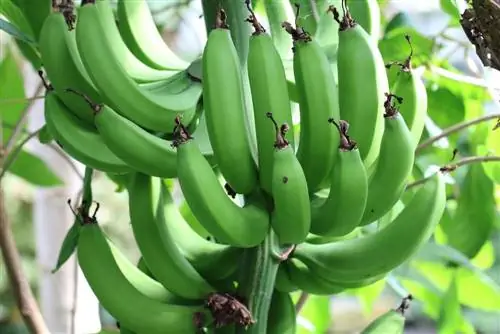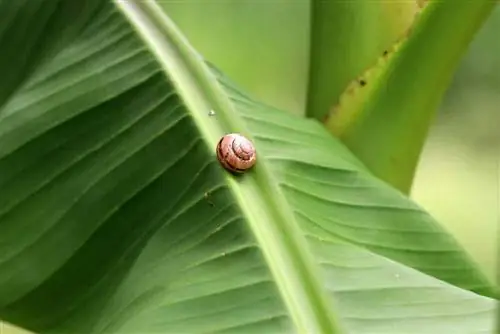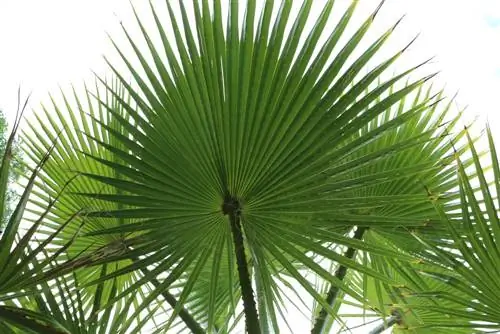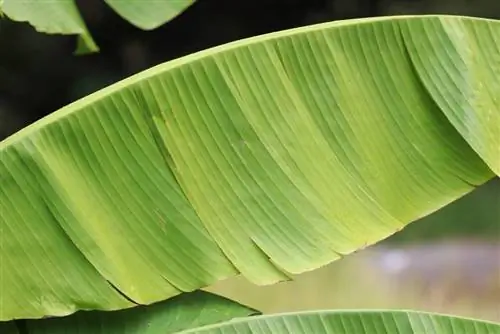- Author admin [email protected].
- Public 2023-12-17 03:39.
- Last modified 2025-06-01 06:48.
The banana palm (Musa) brings a touch of exoticism to Central European gardens, winter gardens, living rooms and balconies. They cannot cope with the local climate unconditionally. They often react sensitively to care errors, which is why experts usually only recommend experienced hobby gardeners to purchase banana plants. But with the following care and wintering tips, even less experienced plant lovers don't have to go without banana palms.
Location tips
Temperatures
The Musa from the banana family (Musaceae) includes many species, all of which require warm temperatures to thrive he althily. The optimal temperatures are between 26 degrees Celsius and 30 degrees Celsius during the day. At night the ideal temperature is 20 degrees Celsius. If the temperature exceeds or falls below these values, this is reflected in the absence or stunting of the fruit. In addition, impaired growth can occur.
Basically make sure that the temperatures do not fall below 14 degrees Celsius and do not rise above 34 degrees Celsius.
Sunlight
Banana palms love the sun. It can be in direct sunlight. If this shines on them around twelve hours a day, Musaceae will reward you with magnificent growth. The ideal location is therefore in the garden or winter garden, where they receive direct sunlight from the east in the morning and from the south from midday until the evening. If it receives less direct sunlight, it will tolerate it, but will grow slower and be more susceptible to disease.
Moisture
Plants that are native to the tropics and subtropics do not want to go without moisture, even in Central Europe. There should be a moisture content of 50 percent. In the warm summer months, combined with many hours of direct sunlight and dry heating air, this means daily spraying. A particularly good tip is to plant several banana palms. This has the advantage that the humidity and the temperature level can be maintained better.
Tips for planting
Soil permeability
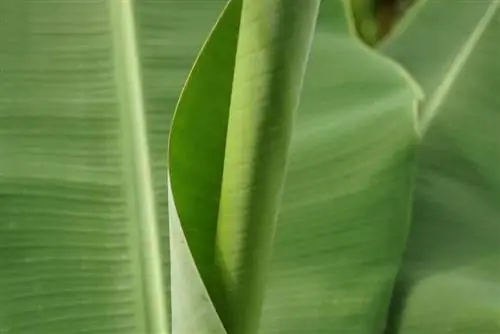
Since the banana palm should be evenly moist, the risk of waterlogging is increased. This in turn increases the risk of rot. To avoid this, good soil permeability must be ensured. This can be achieved if the soil is enriched with 20 percent perlite. This promotes water drainage. Substrate with perlite content is available as a finished product for cultivation in pots. You can test the water drainage in the garden bed in a certain way. Dig a 30 centimeter hole and fill it completely with water. If the water has drained out, pour the same amount of water into the hole again. After an hour, check the water level and measure how much water has seeped away during that time. A reading between seven and 15 centimeters per hour is ideal for banana palms.
Planting spacing
Depending on the type/variety of banana plants, these can reach proud heights of up to ten meters. There should be plenty of space at the top. Under optimal location and care conditions, it also grows in width. It is advisable to find out what type/variety it is so that an appropriate plant spacing can be maintained in the bed.
- Neighboring plants:
If a banana tree is too close to the neighboring plants, it cannot develop freely. In the worst case, it would have to compete for soil moisture, especially in close proximity to moisture-loving plants with extensive root systems. For this reason, it should always be planted at a sufficient distance of around 4.5 meters from plants such as trees and bushes. If several perennials are planted in a group, a minimum planting distance of between three and five meters is optimal. Dwarf banana plants can cope with less space.
Planting hole size
The banana palm presents itself in the ground with a fairly stable, loose root system. If it is buried deeper, it stands more firmly and cannot root out in stronger winds. In places protected from the wind, the hole should be at least 30 centimeters deep and wide. In windy places, the plant hole should be dug to a depth of 50 centimeters.
pot planting
Always use a bucket that has a drainage hole at the bottom. Banana plants are very susceptible to rot. Excess water can escape from the bucket via a drainage hole. This prevents waterlogging. The prerequisite is that you remove the leaked water so that the plant does not remain in the water. In addition, soil drainage made of gravel, pottery shards or quartz sand promotes water drainage from buckets.
- Bucket size:
With banana palms, there is no question of the extent to which growth can be influenced by the size of the container. If a pot is chosen that is too small and the plant's growth is restricted, it will react by forming brown, unsightly leaf colors, which can even lead to them drying out. If you want a banana palm with a shorter height, you should pay attention to the appropriate variety/species when purchasing.
potting soil
In order to ensure optimal supply and appropriate moisture content in the pot, no conventional potting soil or garden soil should be filled. Many hobby gardeners have had good experiences with cactus soil. Alternatively, a high quality, loose substrate with a sand content and perlite can be used for better permeability. The suitable pH value is between 5.5 and 7.0. From 7.5 the Musa will be included.
Stabilization
If the banana plant is firmly planted or potted, an additional stabilizing aid provides more support until the palm roots have anchored themselves in the ground. This measure is recommended for all specimens with a height of one meter or more at the time of planting. The stabilization can remain permanent for fruit formation. This will prevent them from snapping if the fruit becomes too heavy.
- Instructions for stabilizing heavy fruits:
- Material required: two 2 to 3 meter long bamboo tubes or similar hard material and binding wire
- Tie the poles together so that there is a crossing in the upper third, like an “X”
- Place the lower third of the pole ends in the ground so that the cross is approximately five centimeters above the fruit stem
- Place the stabilizer directly on the trunk in the ground and firmly press it down
- Carefully lift the fruit stem and lift it over the cross, which now takes the weight off the fruit stem
Tips for watering
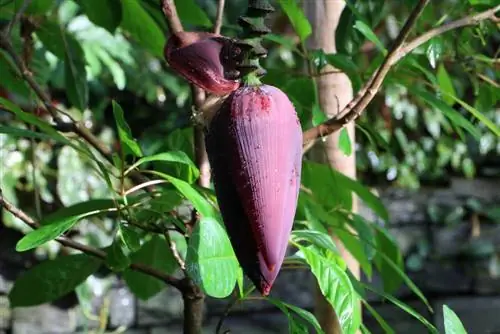
Banana plants require a lot of water, but should still be watered with caution. If they are too dry, they will die - if they are too moist, there is a risk of root rot and usually will not survive this either. The optimal time for watering is when you can press the soil or substrate surface less than 1.5 centimeters with your thumb. If the soil gives way deeper, you should wait before watering.
Tip:
The cooler banana palms are, the lower the water requirement. If the humidity is low, spraying the leaves helps to balance it out.
Young plants
Be careful with young plants that don't yet have leaves! A lot of moisture evaporates through banana leaves. If they are not present, the water requirement is reduced until the leaves form. This is where the risk of overwatering and root rot as a result is usually greatest. For this reason, they should not receive too much direct sunlight. This would promote evaporation.
Fertilizing tips
When it comes to fertilizing, a Musa is frugal. The following applies here: less is more. To ensure optimal nutrient supply, you should adhere to the following tips:
- Fertilize immediately after planting (including young plants)
- Fertilization rhythm: once a month is sufficient if done regularly
- Fertilizer: Complete liquid fertilizer is best - should contain phosphorus, potassium and nitrogen
- Alternative fertilizer: compost
- Do not use fresh manure - it must have been stored for at least two weeks
- Observe the manufacturer's recommended fertilizer amount to avoid over-fertilization - otherwise it could lead to death
- Cultivated specimens as houseplants only require half the amount of fertilizer
- Do not fertilize above a temperature of around 14 degrees Celsius
Fertilization technology
Unlike so-called deep-rooted plants, a special fertilization technique ensures better effectiveness for the shallow-rooted Musa. Here, a fertilizer circle should be drawn around the planting hole or the plant. In this way, the components of the fertilizer can be better distributed on the surface and in this way can better reach the broad root system at the root ends.
Cutting tips
- Brown and dried leaves should be cut off regularly
- Adult banana trees should never have more than one shoot - for more harvest, separate the remaining ones
- Cut off “superfluous” shoots directly at the ground
- Connect Cover interface with earth
- If there are problems with growth, cut the banana tree back to half
Tips for harvesting/fructescence
The formation of a fruit cluster begins with a purple flower, which can take between six and twelve months to appear after planting. You should never remove the petals here as they provide sun protection.
If the petals withdraw, the banana fruits appear on the so-called banana bunch after two to four months. Only when the bananas have developed on the clusters can you remove excess plant parts. If there are clusters on which no fruit develops, these are usually male, infertile “banana hearts”. Allowing them to wither in place and on their own will promote fruit production.
Protection from insects
Banana fruits attract numerous insects. To prevent them from ruining your expected harvest, you should wrap plastic wrap around the fruit clusters. Make sure that they remain open at the top and bottom. In this way, the exchange of water and air is ensured.
Harvest readiness
The perfect time to harvest is when the small flowers at the fruit ends have dried up. In addition, loss of leaves is a clear indication of the right harvest time. Some can be removed beforehand to try it out. If they are separated from the clump, they mature quickly.
Post-harvest care
Separate the clump completely if you have not already done so for harvesting purposes. Shorten the trunk in the middle and remove all but one of the shoots. The mother plant will now die and the sapling will grow in its place.
Tips for wintering
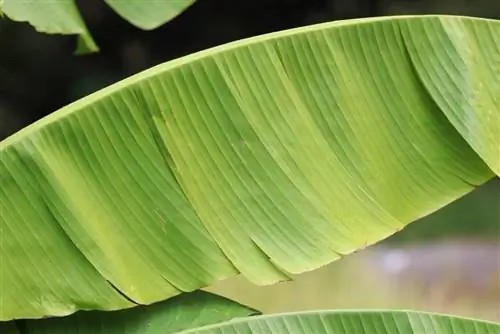
Banana palms cannot survive the winter in these temperatures without suitable winter quarters and preventative care measures. The following tips will ensure that you don't have to buy new banana plants even after winter:
Outdoor Banana Plants
- Place outdoor banana palms in a frost-free place - if necessary, transplant them into a pot
- Moving into winter quarters: beginning of October, depending on the weather forecast
- Cut off the leaves before or after overwintering
- Close interfaces with ash or wax - protects against infections
- A cool winter garden is ideal
- Make sure there is plenty of light
- Room temperature must not fall below 14 degrees
- Do not fertilize and check the moisture level regularly despite the low water requirement
- Put outside again in May at the earliest
Overwintering rhizomes
If you don't want to, or if it's not possible to move from the outdoors to a frost-free winter quarters due to the size, for example, you can separate the rhizomes and let them overwinter in a warm place for the next year. To ensure that they survive, proceed as follows:
- Dig up banana tree
- Separate rhizomes from the mother plant
- Line the container with bark mulch and place rhizomes in it
- Use a damp cloth to cover and keep continuously moist
- Lighting conditions: dark
- Temperature: between five and ten degrees Celsius
- Plant in the ground from May
Hardy Banana Palms
Some species are offered as hardy specimens. This only applies to regions with mild winter temperatures and only short periods of frost. If this is the case, you can spend the winter outdoors if you are protected from the wind and the root area is covered with leaves or brushwood.
This does not apply to typical winters in German-speaking countries. She wouldn't survive the winter here. The “hardy” species include
- Japanese fiber banana (Musa basjoo)
- Wild forest banana (Musa yunnanensis)
- Darjeeling banana (Musa sikkimensis)
- Golden Lotus (Musella lasiocarpa)
- Cheesman banana (Musa cheesmanii)
When the banana palm has to overwinter outside
Although freezing temperatures can be hard on a Musa, there is a chance that with appropriate precautions they can survive the winter in the garden:
- Get a barrel, rain barrel or similar if you don't have one
- Cut out the bottom
- Short the banana tree to a height of around twenty centimeters
- Close the interface generously with ash or special plant wax
- Leave existing leaves on the plant, as interfaces are particularly sensitive to cold
- Tie leaves loosely to the trunk - avoid kinks - if necessary, wrap/place leaves lightly around the trunk
- Put the barrel/barrel over the plant - the plant must be in the middle
- Place wooden blocks or stones about five centimeters high under the barrel/barrel (serves for air balance)
- Fill the interior completely with leaves up to the top edge (has an insulating effect)
- Press the leaves firmly, but do not squeeze them
- Cover the bin/barrel with a polystyrene or wooden plate (weighting prevents it from flying away in the wind)
- As temperatures rise, lift the lid more often to ventilate
- From May the banana palm can stand freely again
Tips for diseases and pests
Whether it's an illness or a pest infestation, it's important to quickly find out what it is and react accordingly.
Diseases
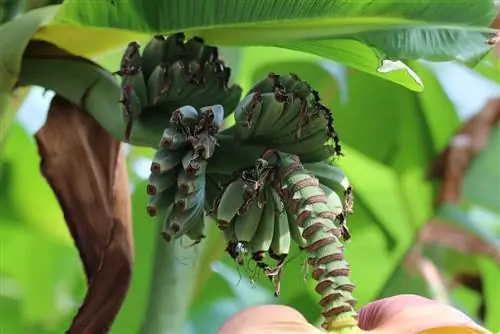
The most common disease is caused by deficiency symptoms. A lack of nitrogen and a lack of potassium are the most common. Other typical illnesses can also occur.
Detecting nitrogen deficiency
- Small leaves and/or light green coloring
- Formation of red to pink leaf edges
- Plant doesn't grow or barely grows
- Fruit clusters remain small
Detecting potassium deficiency
- Orange-yellow leaf discoloration
- Small leaves and cracks in them
- Subsequent leaf dieback
- Flowering appears late or not at all
- Fruit clusters remain small
Bunchy-top-Virose
This is tussock disease, a viral infection that usually only occurs on the dessert banana (Musa × paradisiaca). The disease hardly has any clear characteristics. You can recognize it by the compressed leaves, which look bushy as the disease progresses. As a rule, no fruits form. There is no fight. Affected plants should be disposed of immediately with household waste.
Banana wilt
Banana wilt is caused by the fungus Fusarium oxysporum f. sp. cubense. It spreads through the soil and disrupts the supply of plants. It multiplies rapidly and causes first the leaves and later the entire plant to die. Even the fruits are not safe from the fungus and are no longer suitable for consumption. Combat is not possible. No banana palm should be located in the same place again for at least three years.
Pest Infestation
Mealybugs
If banana palms are in a place that is too cool and dry, the risk of a mealybug infestation increases.
- Recognize:
- Cotton-like, white webs, especially on the undersides of the leaves
- Sticky leaf surfaces due to honeydew
- Tip for combating:
- Prepare highly concentrated soapy water
- Pour into a spray bottle
- Spray the banana tree dripping wet from all directions
- Repeat every three days if necessary
Spider mites
Spider mites primarily attack banana plants that are exposed to dry heating air.
- Recognize:
- White speckles on the leaf surfaces
- Light green to creamy white leaf colors
- Leaves dry up
- Small white or white-greenish insects between the leaves
- Tip for combating:
- Isolate plant from neighboring plants immediately
- Shower/cum vigorously
- Put a translucent plastic film or bag over it and seal it airtight
- Let the banana palm stand for around four days, then open it
- If spider mites are still visible or suspected, repeat the process

